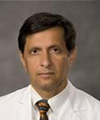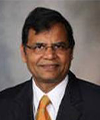Hepatology
Liver Fibrosis
Pharmacologic and Nonpharmacologic Interventions for Nonalcoholic Fatty Liver Disease/Nonalcoholic Steatohepatitis
Overview
Our featured experts consider strategies to intervene against nonalcoholic fatty liver disease/nonalcoholic steatohepatitis (NAFLD/NASH). Lifestyle modifications are expected to remain a cornerstone in the management approach, and pharmacotherapies that are in development appear promising and may emerge in time.
How would you describe the currently available interventions for NAFLD/NASH, and what are the challenges and opportunities?
Raymond T. Chung, MD
|
|
“Weight loss can be frustratingly difficult to attain, but the data are clear that even modest weight reductions can lead to predictable improvements in hepatic steatosis. For example, as little as a 3% weight loss can reduce liver fat content, and reductions of 10% or more are associated with improvements in NAFLD, NASH, and even fibrosis.”
I think that NAFLD is, in so many ways, a disease of lifestyle, and, as a result of the rising standards of living worldwide, NAFLD has become a global problem. The management of this highly prevalent disorder is rooted in the cornerstone of lifestyle changes, and weight reduction is, perhaps, the single most important determinant among them.
Most patients with NAFLD are overweight or obese. Weight loss can be frustratingly difficult to attain, but the data are clear that even modest weight reductions can lead to predictable improvements in hepatic steatosis. For example, as little as a 3% weight loss can reduce liver fat content, and reductions of 10% or more are associated with improvements in NAFLD, NASH, and even fibrosis. These seemingly modest goals, however, are quite difficult to maintain. In fact, more than 90% of patients who are asked to lose weight have a very difficult time keeping the weight off after losing it initially. Other changes, such as incorporating exercise (eg, even modest aerobic exercise) and making dietary modifications, are also associated with improvements in hepatic steatosis and should also be recommended. In the context of morbid obesity and complications such as type 2 diabetes, there may, ultimately, be a strong consideration for weight loss surgery or other bariatric procedures, which have been linked to marked improvements in NAFLD and NASH.
Although there are no US Food and Drug Administration–approved pharmacologic agents for NASH, many different therapies continue to be explored in clinical trials. These agents act on various mechanisms implicated in NAFLD/NASH, such as hepatic lipogenesis, inflammation, and fibrosis. Glucagon-like peptide 1 agonists, which can produce significant weight loss, have been used for some time now in patients with type 2 diabetes and have also produced improvements in both steatosis and steatohepatitis. We hope to see the emergence of 1 or more of these compounds or combinations that could be used in the fight against NASH and, over the long-term, to keep this underlying metabolic disorder at bay and to prevent its complications.
Arun J. Sanyal, MD
|
|
“We talk a lot about the patient’s inability to maintain lifestyle changes, with the implicit implication being that the solution lies in a pill or an injection, but it does not have to be this way. I think that there will be a role for drugs, but there will also be a role for healthy lifestyles.”
Dr Chung nicely covered a lot of ground in his summary. Regarding lifestyle changes, I think that many patients who currently have NAFLD are in the precontemplation stage. I would also emphasize the importance of truly understanding the barriers that are preventing change, on the individual level. No 2 patients are exactly alike, and different factors influence an individual patient’s ability to engage in and maintain these lifestyle changes.
There is a significant mental health overlay in obesity, where there is an overrepresentation of depression. Some people overeat as a way of coping with stress. Further, issues of childhood trauma, posttraumatic stress disorder, and childhood abuse may get layered in. Other important factors include motivational issues and patient lifestyle considerations. Lifestyles are critically linked to work environments, family needs, and the roles that patients play at work and at home. For example, consider a night shift worker who returns from work in the morning, gets their children off to school, helps their spouse get ready for work, and takes care of other family obligations before getting a bit of sleep, waking up in the evening, and then going back to work. This person’s ability to engage in certain lifestyle activities is very different from that of a person who works regular daytime hours.
We talk a lot about the patient’s inability to maintain lifestyle changes, with the implicit implication being that the solution lies in a pill or an injection, but it does not have to be this way. I think that there will be a role for drugs, but there will also be a role for healthy lifestyles. We need to develop personalized solutions, and I would envision the emergence of centers of excellence for NAFLD with resources available to help patients implement these changes. Then the care can be implemented in the primary care setting. We are not quite there yet, but I believe that this is a direction for the future.
Ashwani K. Singal, MD, MS, AGAF, FACG, FAASLD
|
|
“Nonpharmacologic interventions are the backbone of treatment for patients with NAFLD/NASH.”
Nonpharmacologic interventions are the backbone of treatment for patients with NAFLD/NASH. Even if a new treatment is found to be safe, effective, acceptable, and cost-effective, we would still be left with the need for long-term management because drugs are not a long-term solution. In clinical trials, pharmacologic interventions are used for a finite period of time—even though the disease is chronic. Even if a chronic medication may be appropriate, the overall treatment of the patient still requires controlling the risk factors for NAFLD, which include metabolic syndrome and associated conditions such as obesity, diabetes, and dyslipidemia.
Having recognized that nonpharmacologic or lifestyle interventions currently are, and will continue to be, the backbone of NAFLD/NASH management, a focus on weight loss in these patients is important. As noted by Dr Chung, a weight loss of even 3% is sufficient to improve hepatic steatosis. To improve inflammation, the patient may need to achieve a 5% to 7% weight loss, and, to improve fibrosis, a 7% to 10% weight loss may be needed.
We typically tell patients that any net reduction in calories is helpful, whether it is through the implementation of a Mediterranean diet or some other more structured diet. Additionally, we encourage patients to choose the form of exercise that they would like to be doing. We also emphasize to patients that we are not asking them to go on a crash diet or to dramatically change their lives, but rather to make subtle changes that they can live with over time, as the sustainability of weight loss is crucial and is as important as the initial weight loss.
References
Cardoso A-C, de Figueiredo-Mendes C, Villela-Nogueira CA, Sanyal AJ. New drugs for non-alcoholic steatohepatitis. Liver Int. 2020;40(suppl 1):96-101. doi:10.1111/liv.14354
Kanwal F, Shubrook JH, Adams LA, et al. Clinical care pathway for the risk stratification and management of patients with nonalcoholic fatty liver disease. Gastroenterology. 2021;161(5):1657-1669. doi:10.1053/j.gastro.2021.07.049
Michel M, Schattenberg JM. Effectiveness of lifestyle interventions in NAFLD (nonalcoholic fatty liver disease) – how are clinical trials affected? Expert Opin Investig Drugs. 2020;29(2):93-97. doi:10.1080/13543784.2020.1716333
Parlati L, Régnier M, Guillou H, Postic C. New targets for NAFLD. JHEP Rep. 2021;3(6):100346. doi:10.1016/j.jhepr.2021.100346
Ramanan SP, Mohamed MWF, Aung SS, Sange I, Hamid P. Treatment of fatty liver disease: the present and the future. Cureus. 2021;13(1):e12713. doi:10.7759/cureus.12713
Raza S, Rajak S, Upadhyay A, Tewari A, Sinha RA. Current treatment paradigms and emerging therapies for NAFLD/NASH. Front Biosci (Landmark Ed). 2021;26:206-237. doi:10.2741/4892
Tacke F, Weiskirchen R. Non-alcoholic fatty liver disease (NAFLD)/non-alcoholic steatohepatitis (NASH)–related liver fibrosis: mechanisms, treatment and prevention. Ann Transl Med. 2021;9(8):729. doi:10.21037/atm-20-4354
Zhang C, Yang M. Current options and future directions for NAFLD and NASH treatment. Int J Mol Sci. 2021;22(14):7571. doi:10.3390/ijms22147571
Zhu B, Chan S-L, Li J, et al. Non-alcoholic steatohepatitis pathogenesis, diagnosis, and treatment. Front Cardiovasc Med. 2021;8:742382. doi:10.3389/fcvm.2021.742382













